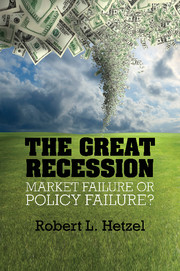Book contents
- Frontmatter
- Contents
- Figures
- Tables
- Preface
- One The 2008–2009 Recession
- Two Recessions
- Three The Great Contraction
- Four Monetary Policy and Bank Runs in the Great Depression
- Five Vigorous Recovery and Relapse
- Six Interwar International Monetary Experiments
- Seven Identifying the Shocks that Cause Recessions
- Eight From Stop-Go to the Great Moderation
- Nine Controlling Bank Risk Taking
- Ten The Housing Crash
- Eleven Bubble Trouble
- Twelve What Caused the Great Recession of 2008–2009?
- Thirteen What Caused the Great Leverage Collapse?
- Fourteen The Distinctions Between Credit, Monetary, and Liquidity Policy
- Fifteen Fed Market Interventions
- Sixteen Evaluating Policy
- Seventeen The Business Cycle
- Eighteen Why Is Learning So Hard?
- Nineteen How Should Society Regulate Capitalism?
- Postscript
- Bibliography
- Index
Seventeen - The Business Cycle
Market Instability or Monetary Instability?
Published online by Cambridge University Press: 05 May 2012
- Frontmatter
- Contents
- Figures
- Tables
- Preface
- One The 2008–2009 Recession
- Two Recessions
- Three The Great Contraction
- Four Monetary Policy and Bank Runs in the Great Depression
- Five Vigorous Recovery and Relapse
- Six Interwar International Monetary Experiments
- Seven Identifying the Shocks that Cause Recessions
- Eight From Stop-Go to the Great Moderation
- Nine Controlling Bank Risk Taking
- Ten The Housing Crash
- Eleven Bubble Trouble
- Twelve What Caused the Great Recession of 2008–2009?
- Thirteen What Caused the Great Leverage Collapse?
- Fourteen The Distinctions Between Credit, Monetary, and Liquidity Policy
- Fifteen Fed Market Interventions
- Sixteen Evaluating Policy
- Seventeen The Business Cycle
- Eighteen Why Is Learning So Hard?
- Nineteen How Should Society Regulate Capitalism?
- Postscript
- Bibliography
- Index
Summary
The business cycle with its alternation of cyclical expansion and contraction is a recurrent feature of the economy. The human misery associated with contractions or recessions manifests a failure of the price system. But what kind of failure? There are two schools of thought. One school, the market-disorder view, which includes the credit-cycle and Keynesian traditions, takes the failure as endemic to a free market system of economic organization. The opposing school, the monetary-disorder (quantity-theory) view, attributes major cyclical instability to interference by central banks with the operation of the price system.
THE ISSUES THAT DIVIDE ECONOMISTS INTO DIFFERENT SCHOOLS
There are two fundamental issues in monetary economics. One issue concerns whether the price level is a real or a monetary phenomenon. Does the price level emerge as an aggregation of dollar prices in individual markets in which those dollar prices are determined by real factors affecting supply and demand particular to those markets? Alternatively, does the price level depend on the monetary arrangements of a country, that is, the way in which the central bank controls money creation?
An alternative formulation of this issue is whether there is a clear distinction between the determination of equilibrium values of nominal and of real variables. How does one give empirical content to the rationality postulate, which states that welfare depends only on real, not nominal, variables? In the quantity-theory tradition, the central bank possesses the power to control nominal variables independently of the behavior of real variables. In particular, it can control the nominal expenditure of the public as the sum of trend growth in real output and a targeted value of inflation.
- Type
- Chapter
- Information
- The Great RecessionMarket Failure or Policy Failure?, pp. 319 - 329Publisher: Cambridge University PressPrint publication year: 2012



